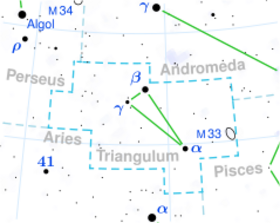Astronomy:R Trianguli
From HandWiki
Short description: M-type giant star
| Observation data Equinox J2000.0]] (ICRS) | |
|---|---|
| Constellation | Triangulum |
| Right ascension | 02h 37m 02.340s[1] |
| Declination | +34° 15′ 51.34″[1] |
| Apparent magnitude (V) | 5.4–12.6[2] |
| Characteristics | |
| Spectral type | M3.5-8IIIe[2] |
| Apparent magnitude (B) | 8.524±0.018 |
| Apparent magnitude (G) | 6.699±0.055 |
| Apparent magnitude (R) | 8.24 |
| Apparent magnitude (J) | 2.23±0.27 |
| Apparent magnitude (H) | 1.36±0.22 |
| Apparent magnitude (K) | 1.05±0.21 |
| Variable type | Mira[2] |
| Astrometry | |
| Radial velocity (Rv) | 67.52±0.88[1] km/s |
| Proper motion (μ) | RA: +34.272[1] mas/yr Dec.: −10.683[1] mas/yr |
| Parallax (π) | 2.4334 ± 0.2487[1] mas |
| Distance | approx. 1,300 ly (approx. 410 pc) |
| Details | |
| Mass | 1.71[3] M☉ |
| Radius | 196±41[4] R☉ |
| Luminosity | 1,784[5] L☉ |
| Surface gravity (log g) | −0.09[1] cgs |
| Temperature | 3184±120[4] K |
| Other designations | |
| Database references | |
| SIMBAD | data |
R Trianguli (abbreviated as R Tri) is a short-period oxygen-rich[4] Mira variable in Triangulum with a period of 266.9 days,[2] discovered by T. H. E. C. Espin in 1890.[7] It is losing about 1.1×10−7 M☉/yr, close to average for a short-period Mira variable.[8] While most short-period Mira variables reside in the Galactic halo, R Trianguli is a member of the thick disk, and its proper motion is fairly high for its distance.[4] Its angular diameter in the K band was measured in 2002 to be, on average, 5.22±0.30 mas, with a shape suggesting that there is an optically thin disk structure surrounding the star.[4]

A visual band light curve for R Trianguli, plotted from AAVSO data[9]
References
- ↑ 1.0 1.1 1.2 1.3 1.4 1.5 Vallenari, A. et al. (2022). "Gaia Data Release 3. Summary of the content and survey properties". Astronomy & Astrophysics. doi:10.1051/0004-6361/202243940 Gaia DR3 record for this source at VizieR.
- ↑ 2.0 2.1 2.2 2.3 "General Catalog of Variable Stars table at VizieR". https://vizier.cds.unistra.fr/viz-bin/VizieR-S?V*%20R%20Tri.
- ↑ Kervella, Pierre; Arenou, Frédéric; Thévenin, Frédéric (2022). "Stellar and substellar companions from Gaia EDR3". Astronomy & Astrophysics 657: A7. doi:10.1051/0004-6361/202142146. ISSN 0004-6361. Bibcode: 2022A&A...657A...7K.
- ↑ 4.0 4.1 4.2 4.3 4.4 Thompson, R. R.; Creech‐Eakman, M. J.; Akeson, R. L. (May 2002). "Time‐dependent Asymmetries in the Atmosphere of the Mira Variable R Trianguli through Infrared Interferometry". The Astrophysical Journal 570 (1): 373–378. doi:10.1086/339736.
- ↑ McDonald, I.; Zijlstra, A. A.; Boyer, M. L. (2012). "Fundamental Parameters and Infrared Excesses of Hipparcos Stars". Monthly Notices of the Royal Astronomical Society 427 (1): 343–57. doi:10.1111/j.1365-2966.2012.21873.x. Bibcode: 2012MNRAS.427..343M.
- ↑ "V* R Tri". SIMBAD. Centre de données astronomiques de Strasbourg. http://simbad.u-strasbg.fr/simbad/sim-basic?Ident=V%2A+R+Tri.
- ↑ Gore, John Ellard (1903) (in en). The Stellar Heavens: An Introduction to the Study of the Stars and Nebulæ. Chatto & Windus. p. 52. https://books.google.com/books?id=NkIJAAAAIAAJ.
- ↑ Jura, M. (February 1994). "The origin and evolution of short-period Miras in the solar neighborhood: Constraints on the life cycle of old stars". The Astrophysical Journal 422: 102. doi:10.1086/173707. Bibcode: 1994ApJ...422..102J.
- ↑ "Download Data". AAVSO. https://www.aavso.org/data-download.
 |


